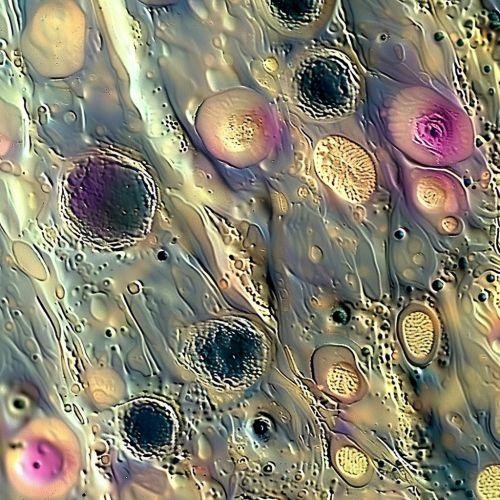Epidermal stem cells: Difference between revisions
(Created page with "== Introduction == Epidermal stem cells are a type of adult stem cell found in the epidermis, the outermost layer of the skin. These cells play a crucial role in the maintenance, repair, and regeneration of the skin. They possess the unique ability to self-renew and differentiate into various cell types that constitute the epidermis, including keratinocytes, melanocytes, and Langerhans cells. This article delves into the biology, functions, and clinical implications of e...") |
No edit summary |
||
| Line 33: | Line 33: | ||
Genetic disorders affecting the skin, such as epidermolysis bullosa, can benefit from epidermal stem cell research. Gene editing techniques like CRISPR-Cas9 can be used to correct genetic mutations in stem cells, which can then be transplanted back into patients to restore normal skin function. | Genetic disorders affecting the skin, such as epidermolysis bullosa, can benefit from epidermal stem cell research. Gene editing techniques like CRISPR-Cas9 can be used to correct genetic mutations in stem cells, which can then be transplanted back into patients to restore normal skin function. | ||
[[Image:Detail-93047.jpg|thumb|center|Microscopic image of epidermal stem cells in the basal layer of the epidermis.]] | |||
== Research and Future Directions == | == Research and Future Directions == | ||
Revision as of 22:38, 21 June 2024
Introduction
Epidermal stem cells are a type of adult stem cell found in the epidermis, the outermost layer of the skin. These cells play a crucial role in the maintenance, repair, and regeneration of the skin. They possess the unique ability to self-renew and differentiate into various cell types that constitute the epidermis, including keratinocytes, melanocytes, and Langerhans cells. This article delves into the biology, functions, and clinical implications of epidermal stem cells.
Biology of Epidermal Stem Cells
Location and Identification
Epidermal stem cells are primarily located in the basal layer of the epidermis and in the hair follicle bulge. The basal layer is the deepest part of the epidermis, where cells are attached to the basement membrane. The hair follicle bulge is a niche that houses a reservoir of stem cells responsible for hair growth and skin regeneration.
Identification of epidermal stem cells involves the use of specific markers such as CD34, keratin 15 (K15), and integrin α6. These markers help distinguish stem cells from other epidermal cells. Advanced techniques like fluorescence-activated cell sorting (FACS) and immunohistochemistry are commonly employed to isolate and study these cells.
Self-Renewal and Differentiation
Epidermal stem cells exhibit two key properties: self-renewal and differentiation. Self-renewal is the process by which stem cells divide to produce identical daughter cells, ensuring a constant supply of stem cells. Differentiation involves the transformation of stem cells into specialized cell types that perform specific functions.
The balance between self-renewal and differentiation is tightly regulated by various signaling pathways, including the Wnt, Notch, and Hedgehog pathways. Disruption in these pathways can lead to skin disorders and diseases.
Functions of Epidermal Stem Cells
Skin Homeostasis
Epidermal stem cells are essential for maintaining skin homeostasis. They continuously replenish the epidermis by producing new keratinocytes, which migrate upwards to replace the shed outermost layer of the skin. This process ensures the skin remains intact and functional.
Wound Healing
In response to skin injury, epidermal stem cells are activated to proliferate and migrate to the wound site. They differentiate into keratinocytes to form new epidermal layers, facilitating wound closure and tissue repair. Growth factors such as epidermal growth factor (EGF) and transforming growth factor-beta (TGF-β) play significant roles in this process.
Hair Follicle Regeneration
Epidermal stem cells located in the hair follicle bulge contribute to hair follicle regeneration. During the hair growth cycle, these stem cells are activated to produce new hair follicles and sebaceous glands. This regenerative capability is crucial for maintaining hair density and health.
Clinical Implications
Skin Disorders
Dysregulation of epidermal stem cells can lead to various skin disorders. For instance, a deficiency in stem cell function can result in chronic wounds and ulcers, while uncontrolled proliferation can contribute to skin cancers such as basal cell carcinoma and squamous cell carcinoma. Understanding the underlying mechanisms of these disorders can aid in developing targeted therapies.
Regenerative Medicine
Epidermal stem cells hold significant potential in regenerative medicine. They can be cultured and expanded in vitro to produce skin grafts for treating burns, chronic wounds, and other skin injuries. Advances in tissue engineering and stem cell therapy are paving the way for innovative treatments that harness the regenerative capabilities of these cells.
Genetic Disorders
Genetic disorders affecting the skin, such as epidermolysis bullosa, can benefit from epidermal stem cell research. Gene editing techniques like CRISPR-Cas9 can be used to correct genetic mutations in stem cells, which can then be transplanted back into patients to restore normal skin function.

Research and Future Directions
Stem Cell Niches
Research on stem cell niches, the microenvironments that support stem cells, is crucial for understanding how epidermal stem cells function. The niche provides signals that regulate stem cell behavior, and alterations in the niche can impact stem cell activity. Studies are exploring how changes in the niche contribute to aging and disease.
Stem Cell Plasticity
Stem cell plasticity refers to the ability of stem cells to adopt different fates under certain conditions. Recent research suggests that epidermal stem cells may possess more plasticity than previously thought, potentially allowing them to differentiate into non-epidermal cell types. This discovery opens new avenues for regenerative medicine and tissue engineering.
Cancer Stem Cells
Cancer stem cells (CSCs) are a subpopulation of cancer cells with stem cell-like properties, including self-renewal and differentiation. In skin cancers, CSCs are believed to drive tumor growth and resistance to therapy. Targeting CSCs could improve treatment outcomes and reduce the risk of recurrence.
